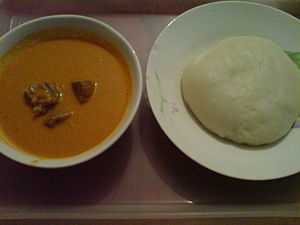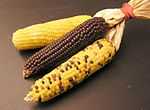Fufu
| Fufu | |||||||
|---|---|---|---|---|---|---|---|
|
A plate of fufu (right) accompanied by peanut soup | |||||||
| Alternative names | foofoo; foufou; fufuo; sakora; sakoro; couscous de Cameroun | ||||||
| Region or state | West Africa | ||||||
| Main ingredients | Usually cassava | ||||||
| 267 kcal (1118 kJ) | |||||||
| |||||||
|
| |||||||


Fufu (variants of the name include foofoo, fufuo, foufou, fufuo) is a staple food of many countries in Africa and the Caribbean. It is often made with a flour made from the cassava plant[lower-alpha 1] – or alternatively another flour, such as semolina or maize flour.
It can also be made by boiling starchy food crops like cassava, yams or cooking plantains and cocoyam then pounding them into a dough-like consistency. Fufu is eaten with the fingers, and a small ball of it can be dipped into an accompanying soup or sauce. Foods made in this manner are known by different names in different places. However, fufu stands out, especially in Ghana and in West Africa in general. Among Hausa communities in Northern Nigeria, it is known as sakora, among the Dagombas of Northern Ghana as sakoro, and as couscous (couscous de Cameroun) in the French-speaking regions of Cameroon (not to be confused with the North African dish couscous).[2]
African fufu
Cassava was introduced to Africa from Brazil by Portuguese traders in the 16th century.[1] In Ghana, before cassava was introduced, fufu was made with yam. In some situations, it is made with plantain or cocoyam. In Nigeria and Cameroon, fufu is white and sticky (if plantain is not mixed with the cassava when pounding). The traditional method of eating fufu is to pinch some of the fufu off in one's right hand fingers and form it into an easily ingested round ball. The ball is then dipped in the soup before being eaten.
A similar staple in the African Great Lakes region is ugali. It is usually made from maize flour (masa), and is also eaten in Southern Africa. The name ugali is used to refer to the dish in Kenya and Tanzania. Closely related staples are called nshima in Zambia, nsima in Malawi, sadza in Zimbabwe, pap in South Africa, posho in Uganda, luku, fufu, nshima, moteke, semoule, ugali and bugari in Republic of the Congo and in the Democratic Republic of the Congo and phaletshe in Botswana.
Caribbean fufu
In the Caribbean and the nations with populations of West African origin, such as Cuba, the Dominican Republic, Haiti and Puerto Rico, plantains or yams are mashed and then the other ingredients are added. In Cuba, the dish retains its original African name, or is also known as fufú de platano. The dish is described respectively as, mangú in the Dominican Republic and mofongo in Puerto Rico. The difference between West African fufu and Caribbean "fufu" is noted in both the texture and the flavorings, Caribbean fufu and mofongo being less of a dough-like and more of a firm consistency.
Mofongo, unlike Caribbean fufu and West African fufu, is fried then mashed with broth, garlic, olive oil, and stuffed with meat (traditional chicharrón). Salsa Criollo (related to American Creole sauce) is poured on top of mofongo. This sauce is typical made with meat, seafood or vegetables. The classic version is severd with chicken broth soup with no sauce. Mofongo has been noted to be more versatile and flavorful then fufu and other Caribbean fufu. It has been called "the big daddy of fufus" and "fufu paella".
The vegetable or source of fufu in the Anglo Caribbean is not fried first. Plantain is not used as much, as it is used in so many dishes. Fufu is usually part of or added to a soupy sauce or on the side with a soupy dish. In Antigua fufu is served as part of the national dish but is called fungi/fungee and is made using cornmeal and okra. Similarly, in Barbados it serves as part of the national dish and is called cou cou and uses cornmeal or, less commonly, breadfruit instead, like several other English Caribbean islands. In Haiti it is called tum tum. It is mostly made of breadfruit but can be made of plantain or yams. Also it is usually served with an okra based stew or soup.
Origin
Fufu, as well as other starchy food, is eaten in a great number of African countries—especially by the Asante, the Akyem, the Bono and the Fante peoples of the Akan ethnic group of Ghana and the Ivory Coast. It features in Guinean cuisine, Cameroonian cuisine, as well as Nigerian cuisine.
Fufu’s prevalence in the West African subregion has been noted in literature produced by authors from that area. It is mentioned in Chinua Achebe’s Things Fall Apart, for example.
Preparation
Pieces of boiled cassava or other tubers are pounded together in a giant wooden mortar using a wooden pestle. In between blows from the pestle, the mixture is turned by hand and water gradually added till it becomes slurry and sticky. The mixture is then formed into a ball or a rounded slab and served. With the invention of the Fufu Machine preparation has become much less labour-intensive.
-

Wooden pestle and mortar for pounding fufu
-

Fufu machine used by a food vendor
Nutrition
Nutritionally, a 100 g serving of fufu contains 2 g of protein, 0.1 g of fat and 84 g of carbohydrate. There are 267 kcal of food energy in a 100 g serving.[3]
See also
References
- Footnotes
- Notes
- ↑ 1.0 1.1 Nweke, Felix I. "THE CASSAVA TRANSFORMATION IN AFRICA". The United Nations. Retrieved 10 June 2014.
- ↑ DeLancey, Mark W., and Mark Dike DeLancey (2000). Historical Dictionary of the Republic of Cameroon, 3rd ed. Lanham, Maryland: The Scarecrow Press, p. 134.
- ↑ "How many calories are in Golden Tropics Cocoyam Fufu Flour". slimkicker.com. SlimKicker. 2013. Retrieved 2 July 2014.
External links
| Wikimedia Commons has media related to Fufu. |
- "Ghana's cooks take to fast fufu". BBC News. 2006-05-29. Retrieved 2008-08-05. - Microwavable instant fufu
| ||||||||||||||||||||||||||||||||||||||||||||||
| ||||||||||||||||||

